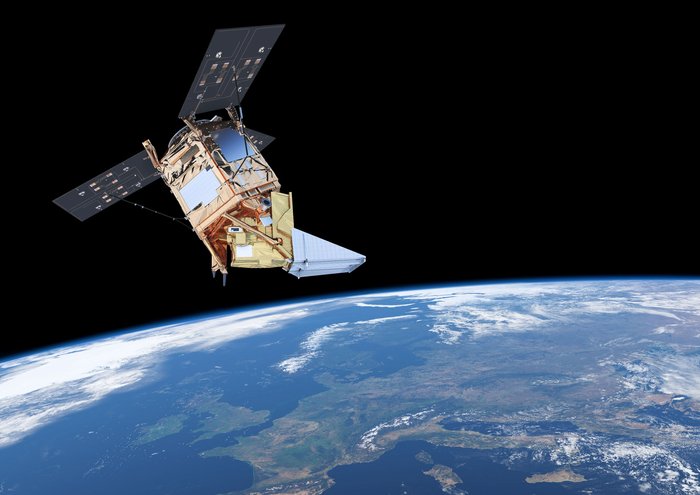Professor Sander Houweling will use the space instrument Tropomi launched last year to calculate worldwide variations in combustion efficiency. Scientists do not yet have sufficient insight into regional variations and trends in this combustion efficiency. Consequently, it is difficult to accurately determine anthropogenic emissions worldwide.

People have a large influence on the chemical composition of the Earth’s atmosphere, especially through the combustion of organic material. Which mix of gas particles is emitted strongly depends on the conditions under which the combustion takes place, an on what is called combustion efficiency in particular.
New method
Sander Houweling, professor at VU Amsterdam and a member of the Earth Science Group of space research institute SRON, will develop a new method to map the global distribution of the combustion efficiency with the help of satellite measurements. He will use data from the Tropomi instrument, which is particularly suitable for this type of research. The Netherlands Space Office (NSO) and the Netherlands Organisation for Scientific Research (NWO) have awarded funding to Houweling’s research proposal for this project.
Polluting substances
Tropomi measures the quantities of nitrogen dioxide and carbon monoxide in the Earth’s atmosphere with unprecedented accuracy. Carbon monoxide and nitrogen dioxide are released – in various ratios – during the combustion of biomass and fossil fuels, and through traffic and industrial activity.
As Tropomi measures these compounds around the world at a high spatial resolution – each day, the whole of the Earth’s atmosphere is imaged at a resolution of 7 x 7 kilometers – it can now be established with far greater accuracy how long the nitrogen oxides remain in the pollution plume measured.
The new model that Houweling uses has far shorter averaging times for quantifying the local emissions of NO2 and CO. This makes it possible to measure seasonal variations and to monitor the combustion efficiency in urban areas and the combustion of biomass over the years.
Tropomi
Tropomi is a collaboration between Airbus Defence and Space Netherlands, KNMI, SRON, and TNO, on behalf of the NSO and ESA. The scientific leadership in the hands of KNMI and SRON. Tropomi is funded by the Ministry of Economic Affairs, the Ministry of Education, Culture and Science, and the Ministry of Infrastructure and the Environment. The instrument is located on board the European satellite Sentinel-5p. The six Sentinel satellites form the space component developed by ESA for the European Commission’s Copernicus program.
Research proposals
Houweling’s project ‘Burning Efficiency based on TROPOMI-derived Tracer Emission Ratios’ (BETTER) is one of eleven new research proposals in the area of observation that has been awarded funding by NSO. The researchers involved will receive a financial boost from the program User Support Space Research (GO) that NSO realizes on behalf of the Netherlands Organisation for Scientific Research (NWO). The GO program offers financial support to researchers working in the Netherlands in order for them to be able to use the infrastructure in space for the purpose of scientific research in the area of Earth observation and planetary research.
BETTER: verbrandingsprocessen in kaart brengen met Tropomi-data
Prof. dr. ir. Sander Houweling gaat met behulp van het vorig jaar gelanceerde ruimte-instrument Tropomi wereldwijde variaties in verbrandingsefficiëntie berekenen. Wetenschappers hebben nog onvoldoende inzicht in regionale variaties en trends in deze verbrandingsefficiëntie. Daardoor is het moeilijk om nauwkeurig de door mensen veroorzaakte uitstoot wereldwijd vast te stellen.

Mensen hebben een grote invloed op de chemische samenstelling van de aardatmosfeer, vooral door het verbranden van organisch materiaal. Welke mix van gas en deeltjes wordt uitgestoten hangt sterk af van de omstandigheden waaronder de verbranding plaatsvindt, met name van de zogeheten verbrandingsefficiëntie.
Nieuwe methode
Sander Houweling, hoogleraar aan de VU en verbonden aan de Earth Science Group van ruimteonderzoeksinstituut SRON, gaat nu een nieuwe methode ontwikkelen om met behulp van satellietmetingen de mondiale verdeling van de verbrandingsefficiëntie in kaart te brengen. Daarbij maakt hij gebruik van de data van het Tropomi-instrument, dat voor dit soort onderzoek uitermate geschikt is. Het Netherlands Space Office (NSO) en de Nederlandse organisatie voor Wetenschappelijk Onderzoek (NWO) hebben het onderzoeksvoorstel daartoe van Houweling gehonoreerd.
Vervuilende stoffen
Tropomi meet nauwkeuriger dan ooit tevoren de hoeveelheden stikstofdioxide en koolmonoxide in de atmosfeer. Koolmonoxide en stikstofdioxide komen – in verschillende verhoudingen – vrij bij de verbranding van biomassa en fossiele brandstoffen en door verkeer en industriële activiteit.
Doordat Tropomi deze verbindingen met hoge ruimtelijke resolutie, wereldwijd meet – elke dag wordt de hele aardatmosfeer in beeld gebracht op een resolutie van 7 x 7 kilometer – kan nu veel beter worden vastgesteld hoe lang de stikstofoxiden in de gemeten pluim zitten.
Het nieuwe model dat Houweling gebruikt heeft veel kortere middelingstijden voor het kwantificeren van de lokale uitstoot van NO2 en CO. Het wordt hiermee mogelijk om seizoensgebonden variaties te meten, en de verbrandingsefficiëntie in stedelijke gebieden en de verbranding van biomassa door de jaren heen te blijven volgen.
Tropomi
Tropomi is een samenwerking tussen Airbus Defence and Space Netherlands, KNMI, SRON en TNO, in opdracht van het NSO en ESA. De wetenschappelijke leiding is in handen van het KNMI en SRON. Tropomi wordt gefinancierd door het Ministerie van Economische Zaken, het Ministerie van Onderwijs, Cultuur en Wetenschap en het Ministerie van Infrastructuur en Milieu. Het Tropomi-instrument bevindt zich aan boord van de Europese satelliet Sentinel-5p. De zes Sentinel-satellieten vormen de door ESA ontwikkelde ruimtecomponent van het Copernicus-programma voor aardobservatie van de Europese Commissie.
Onderzoeksvoorstellen
Houwelings project ‘Burning Efficiency based on TROPOMI-derived Tracer Emission Ratios’ (BETTER) is een van de elf nieuwe onderzoeksvoorstellen op het gebied van aardobservatie die NSO heeft gehonoreerd. De betrokken onderzoekers krijgen een financiële injectie vanuit het programma Gebruikersondersteuning Ruimteonderzoek (GO) dat het NSO uitvoert in opdracht van de Nederlandse Organisatie voor Wetenschappelijk Onderzoek (NWO). Het GO-programma biedt financiële ondersteuning aan in Nederland werkzame onderzoekers bij het gebruik van infrastructuur in de ruimte ten behoeve van wetenschappelijk onderzoek op het gebied van aardobservatie en planeetonderzoek.


